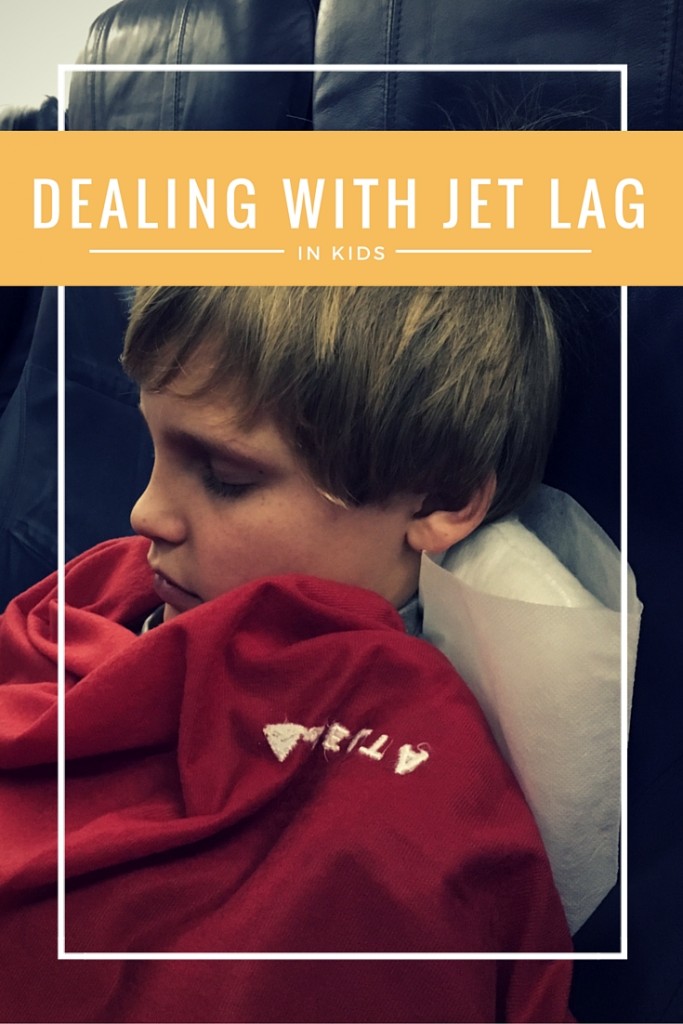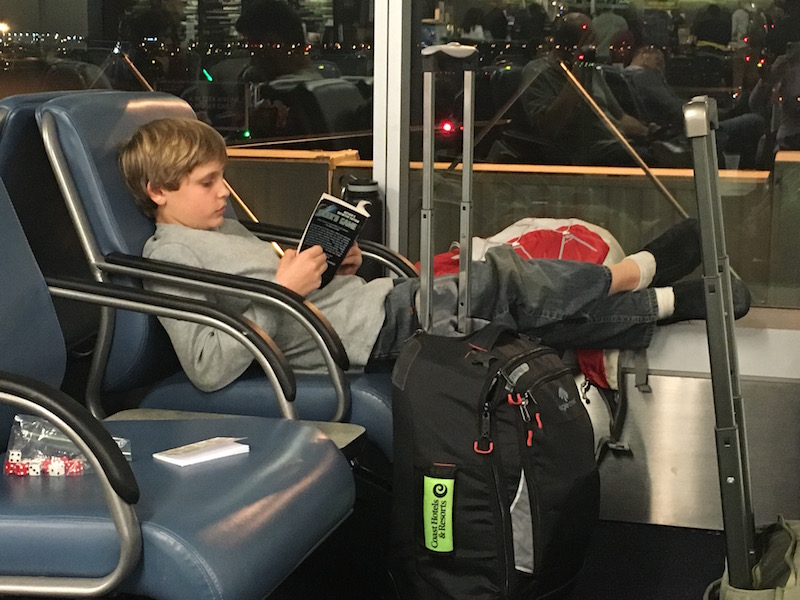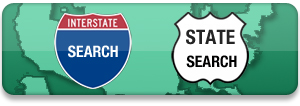On my kids’ first cross-Atlantic journey, we did everything we could to ease the effects of jet lag. We drank a lot of water, got as good a night’s sleep beforehand as possible, and established a ‘bedtime’ on the plane. And everything went well…until our 11-year-old began vomiting as we weaved our way through customs. Not a pleasant story, I know, but nausea is a more common symptom of jet lag than you’d think. Read on for what to watch for, best prevention, and how to deal with jet lag…kids, adults, everyone!

Prevention of jet lag in kids is best:
As noted above, there are steps you can take to help ease the effects of jet lag in kids. Here they are in a nut shell. (And no, we have not found any of the gimmicky natural remedies to work.)
- Drink lots of fluids, especially water. We already drink a large amount of water per day at home, so we thought this would be no problem in flight. However, water is only available every so often. Bring your own refillable water containers and stock up in the airport before your flight or flights. Sip often.
- Pound the Vitamin C. It helps to stay heathy when dealing with jet lag, and traveling across time zones can really wear out your body. This includes your immune system, and the immune systems of kids. We brought Airborne chewables to take every few hours, plus mandated that kids order at least 1-2 glasses of orange juice during complimentary drink services onboard.
- Get sleep the night before. Of course, this is easier said than done if you’re overnighting in an airport hotel or if you have an early morning departure. But do your best. Don’t be tempted to think kids will sleep better on the plane if they skip sleep the night before. An overtired body doesn’t deal with jet lag well.
- Bring pillows, eye shades, ear plugs, and a plan for ‘bedtime’. Again…this is easier said than done. We established a time for our kids to stop watching airplane movies at their seat and lean their seats back to try to sleep. It sort of worked. Banning drinks with caffeine in the evening helped.
Dealing with jet lag once you arrive:
- Drink more water. Be aware that public drinking fountains may be scarce (we find them much more plentiful in the States than abroad). Be prepared to spend a significant sum on bottled water.
- Get Vitamin D, but continue with Vitamin C. Get outside as soon as you can. Take a walk in the neighborhood of your hotel or vacation rental. Avoid going into darker spaces the day you arrive, such as museums or movie theaters.
- Put your watches and clocks on local time immediately, and make yourself (and your family) honor it. Yes, it may feel like 3 am to you, but if it’s lunchtime, eat lunch and be as active as possible. Do your best to prevent naps. It’s far better to allow an early bedtime than to allow kids to nap immediately, unless of course, you want to be up all night.
- Leave an ‘empty’ morning in your itinerary for the day after you arrive. We’re early risers, but after arriving in Paris at about 3 pm local time and pushing ourselves through to 8 pm before going to bed, we still woke at 8 am. We needed those twelve hours of sleep, so I’m glad I didn’t plan a morning activity.
- Consider a sleeping aid for Night 1. We opted to medicate with a mild sleeping pill. This is a personal choice of course, but we found that it helped our older kids fall asleep more easily those first few nights.

A dose of realism: what to look for and expect:
- Difficulty getting to sleep: This seems odd, but even if you or the kids feel very tired, it can be hard to get to sleep if your body thinks it’s mid-day. We found this problem persisted for 4-5 days. To combat it, we did move bedtime back (which allowed for some later evenings out), but still forced ourselves to lie in bed with the lights off before we felt tired. After several days, our bodies made the minor adjustment to be truly on schedule. A natural sleeping aid, reading, or a cup of non-caffeinated tea at bedtime helps, if that’s your thing.
- Nausea: Our son started feeling nauseous and dizzy on the last leg of our three-leg set of flights. By this time, he’d been awake almost 24 hours, with only a few cat naps. Luckily, we grabbed an air sickness bag from the plane before we disembarked, because he lost his breakfast by the time we were queuing for customs. Not fun, but we dealt with it with water and some fresh air. He felt fully recovered by the time we arrived at our accommodations.
- Constipation: Pack an over-the-counter medication of your choice. Check in with kids about their bathroom habits during the first few days. If you have teens, this will embarrass them horribly, which is a fun silver lining.
- Headaches: We also brought Tylenol for headaches, which are common while fighting jet lag. Ultimately, sleep and hydration will fix this problem best.
Realistically, you may not be able to prevent young kids, or even teens, from falling asleep upon arrival. We let ours take a nap between shorter flights (we landed in Rome and took a small jet to Paris) but once we had arrived at our final destination, we immediately went outside, grocery shopped, and explored our neighborhood. Were we tired? Goodness yes. Was it hard to deal with the language barrier while fallowing a grocery list in an unfamiliar store with tired kids? Double yes. But it was worth it when we fell into bed that night!
What are your best tips for combatting jet lag? I’d love to hear them in the comments.





